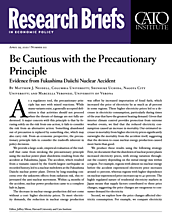We provide a large-scale, empirical evaluation of the tradeoff that came from invoking the precautionary principle using the nuclear power plant shutdowns resulting from the accident at Fukushima, Japan. The accident, which resulted from a tsunami caused by the fourth-largest earthquake in recorded history, led to a nuclear meltdown at the Fukushima Daiichi nuclear power plant. Driven by long-standing concerns over the unknown effects from radiation risk, this rejuvenated the anti-nuclear movement. Within 14 months of the accident, nuclear power production came to a complete halt in Japan.
The decrease in nuclear energy production did not come without a cost: higher electricity prices. To meet electricity demands, the reduction in nuclear energy production was offset by increased importation of fossil fuels, which increased the price of electricity by as much as 38 percent in some regions. These higher electricity prices led to a decrease in electricity consumption, particularly during times of the year that have the greatest heating demand. Given that interior climate control provides protection from extreme weather events, we find that the reduced electricity consumption caused an increase in mortality. Our estimated increase in mortality from higher electricity prices significantly outweighs the mortality from the accident itself, suggesting that the decision to cease nuclear energy production caused more harm than good.
We produce these results using the following strategy. First, we document that the shutdown of nuclear power plants increased electricity prices, with strong variation throughout the country depending on the initial energy mix within a region. For example, regions with almost no nuclear energy before the accident experienced electricity price increases around 10 percent, whereas regions with higher dependence on nuclear experienced price increases up to 40 percent. The highly regulated nature of residential electricity markets in Japan means that supply factors contributed to these price changes, suggesting the price changes are exogenous to consumer demand for electricity. Second, we explore how the price changes affected electricity consumption. For example, we compare electricity consumption in Tokyo in January 2012 to electricity consumption in Tokyo in January 2011. We find that electricity consumption decreased roughly one to two months after price changes occurred. The decreases in electricity consumption are more pronounced during the winter, suggesting there is less protection from the weather during the coldest times of the year.
Third, we explore the consequences from the reduced electricity consumption by estimating how it moderates the temperature-mortality relationship. Similar to previous research, we find that extreme temperatures affect mortality, in particular during very cold temperatures, although the effects from higher temperatures are small given the high rates of air conditioning penetration. We then interact temperature with electricity prices to explore how electricity prices moderate the relationship between temperature and mortality. We find increased mortality effects from extreme cold weather, suggesting the decreased consumption of electricity that resulted from higher electricity prices increased mortality.
To put these estimates in context, we calculate that the higher electricity prices resulted in at least an additional 1,280 deaths during 2011–2014. Since our data only covers the 21 largest cities in Japan, which represents 28 percent of the total population, the total effects for the entire nation are even larger. Meanwhile, the number of deaths due to the Fukushima Daiichi nuclear accident is much lower. No deaths have yet to be directly attributable to radiation exposure, although projections estimate a cumulative 130 deaths. An estimated 1,232 deaths occurred as a result of the evacuation after the accident. Therefore, the deaths from the higher electricity prices likely outnumber the deaths from the accident in only four years if we extrapolate our estimates to the entire country, and almost certainly outnumber the deaths over a longer time period given that the higher electricity prices persisted beyond the end of our study. This suggests that ceasing nuclear energy production has contributed to more deaths than the accident itself.
NOTE:
This research brief is based on Matthew J. Neidell, Shinsuke Uchida, and Marcella Veronesi, “Be Cautious with the Precautionary Principle: Evidence from Fukushima Daiichi Nuclear Accident,” NBER Working Paper no. 26395, October 2019, http://www.nber.org/papers/w26395.

